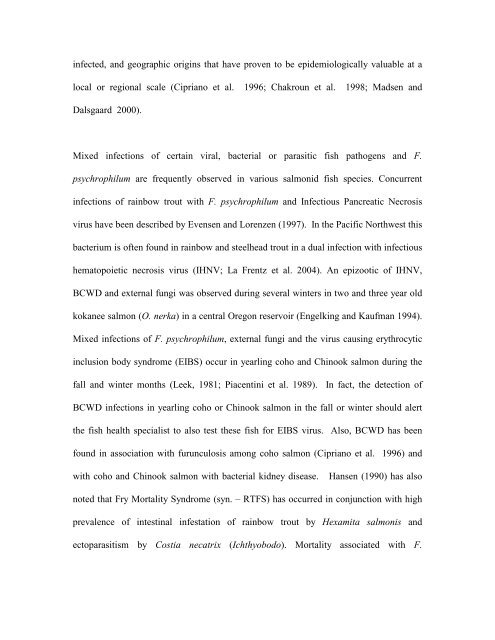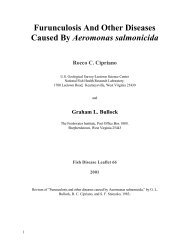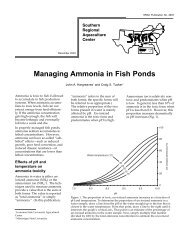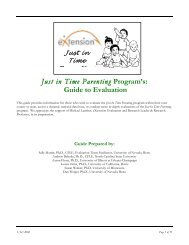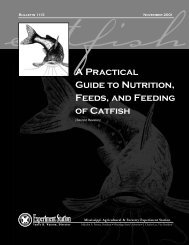Flavobacterium psychrophilum, cause of ... - cop.eXtension.org
Flavobacterium psychrophilum, cause of ... - cop.eXtension.org
Flavobacterium psychrophilum, cause of ... - cop.eXtension.org
Create successful ePaper yourself
Turn your PDF publications into a flip-book with our unique Google optimized e-Paper software.
infected, and geographic origins that have proven to be epidemiologically valuable at a<br />
local or regional scale (Cipriano et al. 1996; Chakroun et al. 1998; Madsen and<br />
Dalsgaard 2000).<br />
Mixed infections <strong>of</strong> certain viral, bacterial or parasitic fish pathogens and F.<br />
<strong>psychrophilum</strong> are frequently observed in various salmonid fish species. Concurrent<br />
infections <strong>of</strong> rainbow trout with F. <strong>psychrophilum</strong> and Infectious Pancreatic Necrosis<br />
virus have been described by Evensen and Lorenzen (1997). In the Pacific Northwest this<br />
bacterium is <strong>of</strong>ten found in rainbow and steelhead trout in a dual infection with infectious<br />
hematopoietic necrosis virus (IHNV; La Frentz et al. 2004). An epizootic <strong>of</strong> IHNV,<br />
BCWD and external fungi was observed during several winters in two and three year old<br />
kokanee salmon (O. nerka) in a central Oregon reservoir (Engelking and Kaufman 1994).<br />
Mixed infections <strong>of</strong> F. <strong>psychrophilum</strong>, external fungi and the virus causing erythrocytic<br />
inclusion body syndrome (EIBS) occur in yearling coho and Chinook salmon during the<br />
fall and winter months (Leek, 1981; Piacentini et al. 1989). In fact, the detection <strong>of</strong><br />
BCWD infections in yearling coho or Chinook salmon in the fall or winter should alert<br />
the fish health specialist to also test these fish for EIBS virus. Also, BCWD has been<br />
found in association with furunculosis among coho salmon (Cipriano et al. 1996) and<br />
with coho and Chinook salmon with bacterial kidney disease. Hansen (1990) has also<br />
noted that Fry Mortality Syndrome (syn. – RTFS) has occurred in conjunction with high<br />
prevalence <strong>of</strong> intestinal infestation <strong>of</strong> rainbow trout by Hexamita salmonis and<br />
ectoparasitism by Costia necatrix (Ichthyobodo). Mortality associated with F.


